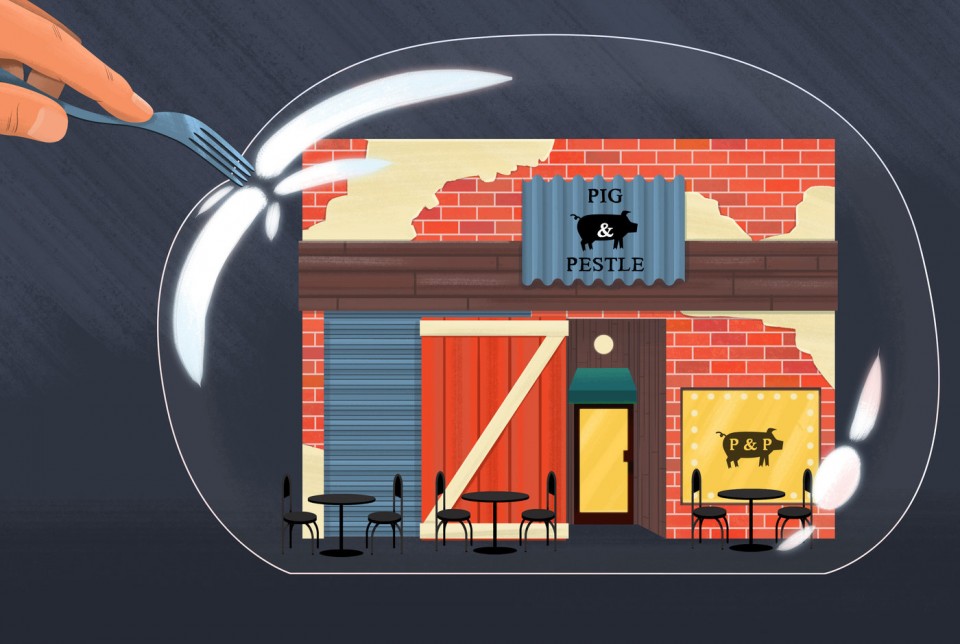
Bubble Bursts For Independent Restaurants
Lisa Jennings | Restaurant-Hospitality.com
For months, industry watchers have been warning about a restaurant bubble about to burst.
It’s a recurring theme that arises whenever a restaurant closes or a chain files bankruptcy. Bubble believers say there are just too many restaurants and not enough people eating out.
“The market is saturated,” said Bonnie Riggs, foodservice industry analyst for research firm The NPD Group, which does twice yearly restaurant counts. “We have more seats than bodies to fill them.”
But for the independent restaurant segment in particular, the bubble has popped, Riggs said. The inevitable correction is clearly taking place, with restaurant counts in serious decline.
In the fall of 2016, for example, there were 620,807 restaurants across the country, down 1.6 percent compared with a year ago. That’s the largest decrease since 1998, when the count began, according to NPD.
That decline amounts to about 9,998 restaurant closures year over year, and most of them were independent restaurants, Riggs said.
The overall count included 221,810 full-service independent restaurants in fall 2016, marking a decline of 3.7 percent year over year for that segment specifically. That translates to a loss of 9,784 independent restaurants.
Meanwhile, the number of chain restaurants grew somewhat, by a count of 2,281 units, or an increase of 0.8 percent. Limited-service restaurants saw the most growth, increasing in number by 7.1 percent, or a net of about 1,560 units, Riggs said.
There have been signs of a weakening climate for full-service restaurants across the board for a year or more.
Higher labor costs have changed the economic equation for many concepts. There are not enough cooks to staff kitchens. Rents in many markets are increasing faster than restaurants, with their very thin margins, can accommodate.

Meanwhile, customers are unwilling to accept higher pricing. Grocery inflation is low and the gap in cost between dining out and eating at home has widened.
“People just think the price-value relationship is out of whack, and they think dining out is a bad value,” Riggs said. “It’s cheaper to eat at home.”
In part as a result, high-end chefs are shifting into the fast-casual segment, with its leaner operating model. That’s where consumers have gravitated and industry prognosticators are predicting more growth.
Chef Mark Ladner is leaving the acclaimed Del Posto in New York to launch a new fast-casual Italian concept called Pasta Flyer in February, for example, though not because of any perceived bubble, according to a spokesperson. He has a mission to make quality Italian food more accessible, he said.
Others have moved toward ultra-high-end omakase or tasting menus, where costs can be controlled and diners may be willing to pay a bit more for an extraordinary experience. But even those examples show signs of trouble.
“Top Chef” contestant Kwame Onwuachi, for example, whose resume includes stints cooking at both Per Se and Eleven Madison Park in New York, opened The Shaw Bijou in Washington, D.C., late last year. Initially, the restaurant featured a $185 per person 17-course tasting menu. A few weeks later, however, Onwuachi lowered the price to $95 per head for seven courses.
Then, only about three months after opening, the restaurant abruptly closed in mid-January. Partners in the concept reportedly blamed high labor and ingredient costs.
Onwuachi, who spoke with Restaurant Hospitality days before announcing the closure, said he wasn’t thinking about any bubble or trends in designing The Shaw Bijou.
“I was thinking more about what do I want to accomplish and achieve,” he said. “It’s always an interesting balance. Being a chef, you’ve got a passion and an art, and you have to balance that with business.”
Thrillist recently made the case for a restaurant bubble about to pop. Writer Kevin Alexander declared America’s Golden Age of Restaurants as coming to an end.
The report pointed to the closure of AQ in San Francisco as almost a poster child for the “perfect restaurant industry storm” on the horizon.
AQ, a 2012 James Beard finalist for best new restaurant in America, served its final dinner on Jan. 14, after five years in business.
But AQ executive chef Mark Liberman disagreed that a restaurant bubble is to blame for the concept’s demise.
“I think AQ has run its course, to be honest,” Liberman said. “It’s two slow years catching up with us.”
The restaurant is located in a “challenging” neighborhood, Liberman said, and although it was hoped that AQ’s early success would bring more critical restaurant mass to the area, that didn’t happen.

In San Francisco, so rich in restaurant options, guests tend to flock to the newest restaurants opening, he said. AQ was a hit early on, but then diners moved on to the next new thing.
“That’s a big trend, with Instagram being so popular and the media pushing what’s new and hot,” Liberman said. “Sometimes it takes a little while for restaurants to find their voice.”
Liberman doesn’t see a bubble so much as a need for restaurant operators to adapt.
In San Francisco, perhaps more than any other city, labor costs have skyrocketed. AQ struggled to deal with rising minimum wage requirements and health care mandates.
“You can only run so long at 40-percent labor [costs] before your growth is impacted,” Liberman said.
Still, Liberman said he plans to jump right back in, after taking a break to travel and dream up his next concept.
He wants to launch his own restaurant group, and he envisions a new format, one with a smaller kitchen staff, while still creating an accessible, full-service experience.
What that might be, he hasn’t quite decided.
“It’s not an easy question to answer,” Liberman said. But it’s probably a question everyone is asking: “How can I run with a smaller team?”

